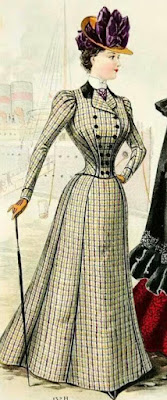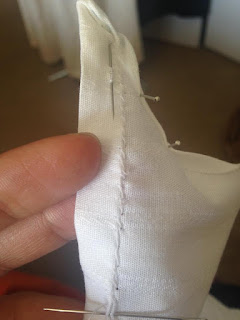Evolution of Black Fashion in the 18th Century
Recently, I came across this article that was floating around on Facebook called "An Indian Chintz Gown: Slavery and Fashion". It was an amazing story about a beautiful Chintz print gown that was stolen from a woman, and then turned around and was sold to 2 different slaves, one of which was George Washington's slave named Charlotte Judge (aka Ona Judge's sister-in law).
The original owner of the dress confronted the new owner Charlotte about the gown when she saw her wearing it in downtown Alexandria, and tried to get it back. Charlotte having paid for the gown fair and square, had augmented the gown the way she wanted it to look; she was a seamstress after all, and was not having any of this woman's lip. Some words were exchanged more than likely, and Charlotte was back on her way to do whatever she needed to do on her day off in Alexandria.
But looking closer into the narrative gave me a BIG insight not only to this remarkable woman as far as her tastes in fashion, but also in fashion during the 18th century. As the article pointed out, Chintz was a fabric that was mostly reserved for the social elite (they could afford it, and therefore was a sign of financial and racial status), while calico prints and solids linens were reserved and provided for domestic slaves; osnaburg (which is a course linen fabric) was for the field hands. Charlotte being an enslaved seamstress, and owning a piece of clothing such as Chintz, was a pretty big reveal that fashion extend beyond its place in society. While high fashion was not accessible to African Americans, they mimicked similarities or created their own fashions that mirrored homage to their African roots.


Another example was Hercules (not pictured here), who was enslaved at Mount Vernon. Though he was the President's chef, Hercules was well known to own his own set of fine clothing. According to written accounts and the book "Never Caught" by Erica Dunbar, Hercules adopted the style of a well dressed Dandy. Resources showed that he owned a well tailored navy blue tailcoat with a walking cane. He too made off with those when he ran away from Mount Vernon a year or so after Judge.
In the mid to late 18th century (even in the peak of the 19th century), Black fashion was more widely eclectic in regions outside the colonies like the sugar plantations in the Caribbean (Jamaica, Hati, Bermuda) and southern territories such as Louisiana. In New Orleans, both French and African cultures intermingled into what is called Louisiana Crèole. With the development of this new budding society, the fashion within the Crèole culture took on a rich identity of its own; components such as religion, heritage, classism and climate (hot during the summer/autumn seasons) dictated the style men and women's wear. However, in the later half of the 18th century legislation encroached on the livelihoods of women and their right of what to wear by enforcing the Tignon Laws of 1786. This law required Crèole women (free and enslaved) to cover their hair to prevent white men from getting distracted by their natural hairstyles. This expanded not only to the southern colonies and territories but also to the middle colonies such as Virginia, and Maryland (though the Tignon Laws were not enforced there, the style was adopted). In Louisiana the law was enforced for almost a century and a half later. The tignon became a staple in black women's fashion and identity; finding ways to adapt to this law made women use their creative side. They created new styles of Tignons and would often mix colors, fabrics and would add items such as feathers, beads, and plenty of bows and twists. This style later becomes popular among white society and is adopted into the early the Regency Period.
Below are a variety of examples of Crèole men and womens clothing and different styles of Tignons.





My recreation of this adorable young lady wearing a lightweight muslin Tignon (taken during my internship at CW)
Further south, African-Caribbean fashion was definitely something of its own. Heavily influenced by African traditions and American imported fabrics, clothing in the islands required very lightweight and brightly colored fabrics such as linens and cottons to protect the wearer from humid and tremendous heat during the summer and autumn months. While tignons and headwraps were the norm for both enslaved, mistresses who owned slaves, and freed women (and men apparently), this was mostly for practicality and to protect the wearer from the sun and humidity. However upon closer observation the colors and patterns resemble much of the the same as the prints in Africa. All in all, fashion was forced to collaborate with practicality while at the same time upholding the traditions of African heritage. The other-side to it is the accessibility to certain fabrics. Free women and men who did and did not own slaves had access to finer fabrics and jewelry while the enslaved wore clothing that was more practical to working in the sugar cane fields or in the domestic homes.
My final example is of the famous English painting of Dido Belle Lindsay who was noted for this beautiful painting she did with her cousin Elizabeth. Dido is depicted wearing a silk taffeta gown, a string of pearls, and a matching silk tignon with a feather plume.
There are plenty more examples I could give in regards to black fashion in the 18th century and how culture and society, climate, the law, preservation and a mix of multiculturalism inspired an unseemingly new form of fashion that expanded even beyond the turn of the following centuries.
The original owner of the dress confronted the new owner Charlotte about the gown when she saw her wearing it in downtown Alexandria, and tried to get it back. Charlotte having paid for the gown fair and square, had augmented the gown the way she wanted it to look; she was a seamstress after all, and was not having any of this woman's lip. Some words were exchanged more than likely, and Charlotte was back on her way to do whatever she needed to do on her day off in Alexandria.
But looking closer into the narrative gave me a BIG insight not only to this remarkable woman as far as her tastes in fashion, but also in fashion during the 18th century. As the article pointed out, Chintz was a fabric that was mostly reserved for the social elite (they could afford it, and therefore was a sign of financial and racial status), while calico prints and solids linens were reserved and provided for domestic slaves; osnaburg (which is a course linen fabric) was for the field hands. Charlotte being an enslaved seamstress, and owning a piece of clothing such as Chintz, was a pretty big reveal that fashion extend beyond its place in society. While high fashion was not accessible to African Americans, they mimicked similarities or created their own fashions that mirrored homage to their African roots.


Using my own Chintz gown as an example
Other examples of African Americans wearing fine clothing in the 18th century was the wardrobe of Ona Judge, a former slave of Martha Washington. As I pointed out in my previous series, I did a lot of research on her to prepare for my interpretation. I learned that she wore a lot of fine clothing that Martha Washington provided for her, and took them with her when she ran away to New Hampshire.
"She has many several changes of good clothes of all sorts, but they are not sufficiently recollected to be described as there was no suspicion of her going off nor no provocation to do so."
 |
| Ona Judge's Runaway Ad in May 23, 1796 |
 |
| Example of a well dressed man in early 19th century; possibly military uniform |
In the mid to late 18th century (even in the peak of the 19th century), Black fashion was more widely eclectic in regions outside the colonies like the sugar plantations in the Caribbean (Jamaica, Hati, Bermuda) and southern territories such as Louisiana. In New Orleans, both French and African cultures intermingled into what is called Louisiana Crèole. With the development of this new budding society, the fashion within the Crèole culture took on a rich identity of its own; components such as religion, heritage, classism and climate (hot during the summer/autumn seasons) dictated the style men and women's wear. However, in the later half of the 18th century legislation encroached on the livelihoods of women and their right of what to wear by enforcing the Tignon Laws of 1786. This law required Crèole women (free and enslaved) to cover their hair to prevent white men from getting distracted by their natural hairstyles. This expanded not only to the southern colonies and territories but also to the middle colonies such as Virginia, and Maryland (though the Tignon Laws were not enforced there, the style was adopted). In Louisiana the law was enforced for almost a century and a half later. The tignon became a staple in black women's fashion and identity; finding ways to adapt to this law made women use their creative side. They created new styles of Tignons and would often mix colors, fabrics and would add items such as feathers, beads, and plenty of bows and twists. This style later becomes popular among white society and is adopted into the early the Regency Period.
Below are a variety of examples of Crèole men and womens clothing and different styles of Tignons.
 |
| Thandie Newtwon as Yvette from Interview with a Vampire |





My recreation of this adorable young lady wearing a lightweight muslin Tignon (taken during my internship at CW)
To take it a step further, I'm extending it over to Europe as a little bonus. Black fashion experienced similar instances where African influence melted in with European fashions of the time. Unfortunately, I do not have the resources available to elaborate but I definitely plan to revisit this article in the near future. Of what I can touch on, there were examples of such influence.
 |
| An African-Danish (?) man holding a baby. |
 |
| Portrait of Young black man in Italy 1760 |
 |
| Portrait of Young Man |
My final example is of the famous English painting of Dido Belle Lindsay who was noted for this beautiful painting she did with her cousin Elizabeth. Dido is depicted wearing a silk taffeta gown, a string of pearls, and a matching silk tignon with a feather plume.
There are plenty more examples I could give in regards to black fashion in the 18th century and how culture and society, climate, the law, preservation and a mix of multiculturalism inspired an unseemingly new form of fashion that expanded even beyond the turn of the following centuries.
For your reading pleasure:







.jpg)


Perfectly beautiful as always. This is so timely for me. I have been trying to talk our costumer into making me a gown or altering some for me to wear for my interpretation of Charlotte. Of course its was all like, " send me references. Why would you need or wear chintz? Blah blah blah. Anyway after I sent the info and now 6 weeks have passed I still dont ha e qhat I need or want. Any way. Great research and presentation !
ReplyDelete